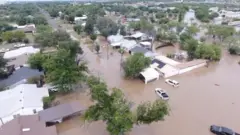Texas Devastated by Flash Floods: Questions Arise Over Early Warning Systems
Central Texas is grappling with the aftermath of devastating flash floods that have claimed the lives of nearly 80 people, with officials cautioning that the death toll is expected to rise as rescue operations continue. The catastrophic event, characterized by an unprecedented deluge of rainfall, has raised critical questions about the adequacy and timeliness of flood warnings issued to residents.
The most severe impact has been felt in Kerr County, where a staggering 28 children were among the victims. A girls’ camp in the area was tragically inundated, leading to immense loss of life. Local officials, including Kerr County Judge Rob Kelly, have expressed surprise at the intensity of the flooding, stating that there was no prior indication of such a catastrophic event. “We had no reason to believe that this was gonna be any, anything like what’s happened here. None whatsoever,” Kelly remarked, highlighting the unexpected nature of the disaster.
Timeline of Warnings Amidst Rising Waters
The flash floods commenced on Thursday night and persisted into Friday morning. Meteorologists have reported that the region experienced several months’ worth of rainfall in a matter of hours. The Guadalupe River, a significant waterway, saw a dramatic rise of 26 feet (8 meters) within just 45 minutes, leading to its banks being breached.
- On Wednesday, the Texas Division of Emergency Management (TDEM) proactively activated state emergency response resources in anticipation of increased flooding threats in West and Central Texas.
- Thursday afternoon saw the National Weather Service (NWS) issue a flood watch, specifically identifying Kerr County as an area with a high risk of flash flooding overnight.
- At 01:14 local time (06:14 GMT) on Friday, a flash flood warning was officially issued for Kerr County.
- Further escalating the alerts, an emergency flash flood warning for Kerr County was issued at 04:03 local time (09:30 GMT), followed by another for the Guadalupe River at 05:34.
Examining the Effectiveness of Public Warnings
Following the disaster, Texas Governor Greg Abbott emphasized that while Texans are accustomed to flood warnings, the sheer scale of this event, described as a “water wall of almost 30ft high,” was beyond any previous experience or expectation.
Nim Kidd, chief of the Texas Division of Emergency Management, pointed out challenges in communication, particularly in areas with limited or no cell phone coverage, stating, “It doesn’t matter how many alert systems you sign up for, you’re not going to get that.” This underscores the vulnerability of certain populations during emergencies.
Concerns have also been raised about public desensitization to frequent weather alerts. Kerrville City Manager Dalton Rice noted that the situation evolved with alarming speed, recounting how a light rain during his early morning jog quickly escalated into a dangerous flood, nearly trapping him in a park. “But by 05:20, the water had risen so fast ‘we almost weren’t able to get out of the park,’ he said.”
Judge Kelly revealed that Kerr County had previously considered implementing a siren-based warning system, similar to those used for tornadoes, but the significant cost deterred its implementation. This highlights a potential gap in county-level preparedness infrastructure.
The National Weather Service (NWS) expressed its sorrow over the tragic loss of life and defended its actions. The NWS stated that forecast briefings were provided to emergency management on July 3, followed by a Flood Watch in the early afternoon. Crucially, Flash Flood Warnings were issued on the night of July 3 and the early morning of July 4, providing “preliminary lead times of more than three hours before warning criteria were met.” Experts cited by The New York Times suggested that the NWS forecasts were as accurate as possible, given the extreme and rapidly escalating nature of the rainfall and storm.
Impact of Staffing and Budget Cuts on Weather Services
The tragedy has also brought attention to potential impacts of past budget cuts on the National Oceanic and Atmospheric Administration (NOAA), the parent agency of the NWS. Concerns have been voiced by meteorologists regarding reduced numbers of weather balloons used for atmospheric observations, which could affect forecasting accuracy. Reports from The New York Times suggested that vacant critical positions within the NWS might have hindered coordination efforts with local emergency managers.
However, countering these concerns, Tom Fahy, legislative director of the NWS Employees Organization, asserted that weather forecasting offices (WFOs) “had adequate staffing and resources as they issued timely forecasts and warnings leading up to the storm.” This sentiment was echoed by Associated Press reports quoting Jason Runyen, an NWS meteorologist, who confirmed that the office covering the affected central Texas area had five staff members on duty during the storms, exceeding the usual two.
Government Response and Future Preparedness
In response to inquiries about the government’s role in preparedness and early warnings, US Homeland Security Secretary Kristi Noem acknowledged the inherent difficulty in predicting weather patterns but affirmed President Donald Trump’s commitment to modernizing the existing warning systems. Secretary Noem stated she would convey the concerns regarding warning systems back to the federal government, emphasizing a priority to upgrade “technologies that have been neglected for far too long.”
Secretary Noem highlighted that while the NWS has historically performed well, the administration is focused on enhancing technology to improve warning lead times. President Trump’s administration is reportedly prioritizing upgrades to the technology used for delivering warnings, with ongoing reforms aimed at addressing these critical needs. The President is also considering a visit to the affected area.

